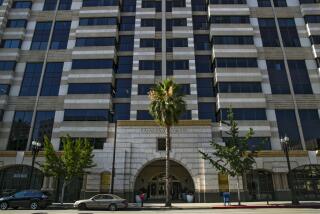Biovest Partners Repeatedly Hits Pay Dirt : Entrepreneurs: Four of the six companies that the venture capital concern helped start up have either gone public or plan to soon.
SAN DIEGO — The venture capital industry may be in eclipse, but Biovest Partners of San Diego is in the chips, having created six companies from scratch since 1986, much to the pecuniary benefit of the venture firm’s investors and the local economy.
Biovest Partners was founded in late 1986 by ex-Hybritech executives Howard E. (Ted) Greene and Timothy J. Wollaeger. Beginning with $6 million chipped in by the two general partners, Stanford University, Hillman Ventures, Sutter Hill Ventures and 25 other investors, Biovest’s holdings are now worth more than $60 million, a tenfold return.
During its first year of existence, Greene and Wollaeger dished out “seed capital” to six companies when the six were little more than concepts built around kernels of technology. But their investments didn’t stop there. They took a hands-on approach to getting the companies on their feet by writing business plans, hiring the companies’ top executives, and in some cases leasing laboratory and office space.
Those efforts have begun to pay off. Of the six companies started by Biovest, two--Cytel and Amylin Pharmaceuticals--have gone public in offerings that raised a total of $108 million. Two others, Pyxis and Neurex, are on the verge, having filed for regulatory permission for initial stock offerings. The other two, Biosite Diagnostics and Vical, are good bets to go public at some future date.
Although there is no guarantee that any or all of Biovest’s six companies will be successful over the long term, the six clearly have progressed further and faster than most young start-ups their age.
One clear winner, so far, is the San Diego economy. The five Biovest-spawned companies with headquarters in San Diego--only Menlo Park-based Neurex is outside the city--have a combined payroll of 450 and spend about $50 million annually in local salaries, office and laboratory leases, outside services and purchases.
“People like Ted Greene seem to have that uncanny ability to pick and create winners,” said Dan Pegg, executive director of the Economic Development Corp., the quasi-public local agency charged with attracting and retaining industry and jobs in San Diego. “He keeps identifying, investing, nurturing and growing these new companies, which are really the backbone of San Diego’s future.”
Also favorably impressed is Philip S. Paul, chairman of Paul Capital Partners in Menlo Park, a longtime venture capitalist who was one of Biovest’s early stage investors.
“Speaking from the perspective of one who is a limited partner in 40 venture capital firms, I would say Biovest’s success rate is remarkable,” Paul said. “It’s more common that, of Biovest’s six companies, you would have two absolutely fail, another two return your capital and the other two do better than return capital. In Biovest’s case, it’s distinctly possible they will have all six in the category of winners, not just two.”
Another Biovest investor from the San Francisco Bay area who asked not to be identified said that, for Biovest to have started up “so many winners out of such small list is just spectacular. No matter how you are comparing, that is wonderful performance.”
Biovest’s success is all the more striking when compared against the dismal performance of the venture capital industry in general, an industry that has seen a sharp decline in new dollars flowing in as investors’ disenchantment with the highly speculative investments has spread. The disenchantment was largely a product of the 1987 stock market crash and of the over-investment in the 1980s that saw too many undeserving companies receive venture funds before going broke.
Last year, investors’ disenchantment was reflected in the fact that only $1.3 billion in new venture capital funds was raised nationwide, a fraction of the peak total of $4.9 billion raised in 1987, according to Venture Capital Journal, a New York-based trade publication. The bulk of new venture funds traditionally has come from institutional investors looking to diversify their assets out of simply stocks and bonds.
Ironically, Biovest Partners is no longer in the business of attracting investment capital or finding new companies to help start. Both Greene, 49, and Wollaeger, 48, decided a couple of years ago that they were happiest managing companies, not an investment portfolio. Greene now spends most of his time as chief executive of Amylin, and Wollaeger is chief executive of Sutter Corp., a non-Biovest related company that makes orthopedic rehabilitation equipment.
But, in the thick of their early venture capital activities, Greene and Wollaeger were a formidable team by all accounts, each with strengths that counterbalanced and complemented the other’s. Both have MBAs--Greene from Harvard and Wollaeger from Stanford--but the similarities end there.
“Ted is a risk-taker, visionary and promoter in the best sense of the word who has the ability to identify that kernel of gold and get enormous amounts of mileage and enthusiasm out of it so that, in the end, the idea, the technology, is a self-fulfilling prophecy,” saidJay Kranzler, chief executive of Cytel, which in November became the first Biovest company to go public.
Wollaeger, more results-oriented, is a “perfect counterpart to Ted. They are diametrically opposed in the way they think. Tim is not so much the visionary but very practical, down to earth, touching and feeling things rather than painting the pot gold at the end of the rainbow,” Kranzler said. “They play off each other very well.”






